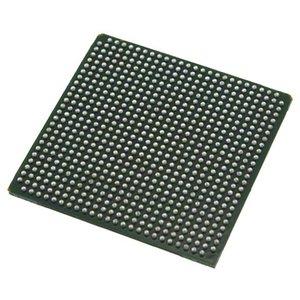
Altera Corporation
EPF10K30AFC484-2N
EPF10K30AFC484-2N ECAD Model
EPF10K30AFC484-2N Attributes
| Type | Description | Select |
|---|---|---|
| Pbfree Code | Yes | |
| Rohs Code | Yes | |
| Part Life Cycle Code | Transferred | |
| Supply Voltage-Nom | 3.3 V | |
| Propagation Delay | 700 ps | |
| Number of Dedicated Inputs | 4 | |
| Number of I/O Lines | 246 | |
| Programmable Logic Type | LOADABLE PLD | |
| Temperature Grade | COMMERCIAL | |
| Package Shape | SQUARE | |
| Technology | CMOS | |
| Organization | 4 DEDICATED INPUTS, 246 I/O | |
| Additional Feature | 1728 LOGIC ELEMENTS; 216 LABS | |
| Clock Frequency-Max | 80 MHz | |
| Output Function | REGISTERED | |
| Supply Voltage-Max | 3.6 V | |
| Supply Voltage-Min | 3 V | |
| JESD-30 Code | S-PBGA-B484 | |
| Qualification Status | Not Qualified | |
| JESD-609 Code | e1 | |
| Operating Temperature-Max | 70 °C | |
| Peak Reflow Temperature (Cel) | 260 | |
| Time@Peak Reflow Temperature-Max (s) | 40 | |
| Number of Terminals | 484 | |
| Package Body Material | PLASTIC/EPOXY | |
| Package Code | BGA | |
| Package Shape | SQUARE | |
| Package Style | GRID ARRAY | |
| Surface Mount | YES | |
| Terminal Finish | Tin/Silver/Copper (Sn/Ag/Cu) | |
| Terminal Form | BALL | |
| Terminal Pitch | 1 mm | |
| Terminal Position | BOTTOM | |
| Width | 23 mm | |
| Length | 23 mm | |
| Seated Height-Max | 2.1 mm | |
| Ihs Manufacturer | ALTERA CORP | |
| Part Package Code | BGA | |
| Package Description | BGA, | |
| Pin Count | 484 | |
| Reach Compliance Code | compliant | |
| ECCN Code | 3A991.D | |
| HTS Code | 8542.39.00.01 |
EPF10K30AFC484-2N Datasheet Download
EPF10K30AFC484-2N Overview
The chip model EPF10K30AFC484-2N is a versatile, high-performance device designed for digital signal processing, embedded processing, and image processing. It has the capability to handle complex data processing tasks, making it an ideal choice for use in a wide range of applications.
The EPF10K30AFC484-2N is based on the Altera FPGA architecture, which is a highly programmable logic device. It is capable of performing various operations such as arithmetic, logic, and data manipulation. It can be programmed using the HDL (Hardware Description Language), which is a powerful language for designing and coding digital circuits.
The EPF10K30AFC484-2N is a very efficient device for data processing, and it is capable of performing complex calculations quickly. It is also capable of handling large amounts of data, making it a suitable choice for applications such as high-speed data processing and image processing.
The EPF10K30AFC484-2N is also suitable for use in the development and popularization of future intelligent robots. The device is capable of performing a variety of tasks, such as recognizing objects, navigating, and responding to external stimuli. It can be used to control robotic arms, legs, and other robotic parts. To use the EPF10K30AFC484-2N effectively, one must have a good understanding of HDL and the specific design requirements of the device.
In addition to the technical requirements for using the EPF10K30AFC484-2N, there are also some practical considerations that must be taken into account. For example, the device requires a power supply and a clock source to operate correctly. It is also important to consider the environmental conditions in which the device is to be used, as certain environmental conditions may affect the performance of the device.
Case studies are also useful for understanding the capabilities and limitations of the EPF10K30AFC484-2N. By studying actual applications of the device, one can gain a better understanding of the performance and potential of the device. This can help to identify any potential issues that may arise when using the device, and can also provide ideas for improving the design of the device.
In conclusion, the EPF10K30AFC484-2N is a versatile, high-performance device that is suitable for a variety of applications. It is capable of performing complex calculations and handling large amounts of data. It is also suitable for use in the development and popularization of future intelligent robots. To use the EPF10K30AFC484-2N effectively, one must have a good understanding of HDL and the specific design requirements of the device, as well as practical considerations such as power supply and environmental conditions. Case studies can also be useful for understanding the capabilities and limitations of the device.
You May Also Be Interested In
1,592 In Stock
Pricing (USD)
| QTY | Unit Price | Ext Price |
|---|---|---|
| No reference price found. | ||


